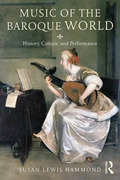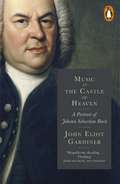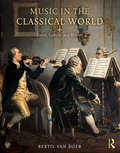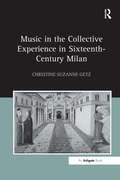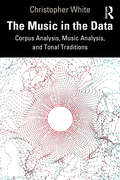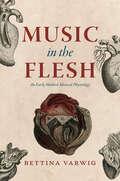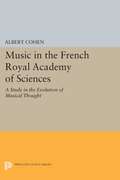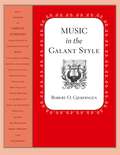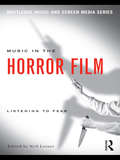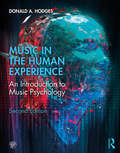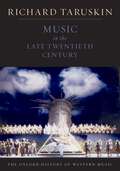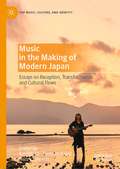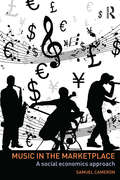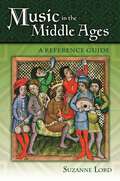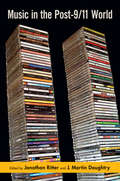- Table View
- List View
Music in the Baroque World: History, Culture, and Performance
by Susan Lewis HammondMusic in the Baroque World: History, Culture, Performance offers an interdisciplinary study of the music of Europe and the Americas in the seventeenth and first half of the eighteenth centuries. It answers calls for an approach that balances culture, history, and musical analysis, with an emphasis on performance considerations such as notation, instruments, and performance techniques. It situates musical events in their intellectual, social, religious, and political contexts and enables in-depth discussion and critical analysis. Features An interdisciplinary approach that balances detailed analysis of specific pieces of music and broader historical overview and relevance A selection of historical documents at the end of each chapter that position musical works and events in their cultural context Extensive musical examples that show the melodic, textural, harmonic, or structural features of baroque music and enhance the utility of the textbook for undergraduate and graduate music majors A global perspective with a chapter on Music in the Americas A companion score anthology and website with links to audio/video content of key performances and research and writing guides Music in the Baroque World: History, Culture, Performance tells stories of local traditions, cultural exchange, performance trends, and artistic mixing. It illuminates representative works through the lens of politics, visual arts, theology, print culture, gender, domesticity, commerce, and cultural influence and exchange.
Music in the Castle of Heaven: A Portrait of Johann Sebastian Bach
by John Eliot GardinerJohann Sebastian Bach is one of the most unfathomable composers in the history of music. How can such sublime work have been produced by a man who (when we can discern his personality at all) seems so ordinary, so opaque - and occasionally so intemperate?John Eliot Gardiner grew up passing one of the only two authentic portraits of Bach every morning and evening on the stairs of his parents' house, where it hung for safety during the Second World War. He has been studying and performing Bach ever since, and is now regarded as one of the composer's greatest living interpreters. The fruits of this lifetime's immersion are distilled in this remarkable book, grounded in the most recent Bach scholarship but moving far beyond it, which explains in wonderful detail the ideas on which Bach drew, how he worked, how his music is constructed, how it achieves its effects - and what it can tell us about Bach the man.Gardiner's background as a historian has encouraged him to search for ways in which scholarship and performance can cooperate and fruitfully coalesce. This has entailed piecing together the few biographical shards, scrutinising the music, and watching for those instances when Bach's personality seems to penetrate the fabric of his notation. Gardiner's aim is 'to give the reader a sense of inhabiting the same experiences and sensations that Bach might have had in the act of music-making. This, I try to show, can help us arrive at a more human likeness discernible in the closely related processes of composing and performing his music.'It is very rare that such an accomplished performer of music should also be a considerable writer and thinker about it. John Eliot Gardiner takes us as deeply into Bach's works and mind as perhaps words can. The result is a unique book about one of the greatest of all creative artists.SIR JOHN ELIOT GARDINER is one of the world's leading conductors, not only of Baroque music but across the whole repertoire. He founded the Monteverdi Choir and Orchestra, the Orchestre de l'Opéra de Lyon, the English Baroque Soloists, and the Orchestre Revolutionnaire et Romantique. He has conducted most of the world's great orchestras and in many of the leading opera houses. He lives and farms in Dorset.
Music in the Classical World: Genre, Culture, and History
by Bertil van BoerMusic in the Classical World: Genre, Culture, and History provides a broad sociocultural and historical perspective of the music of the Classical Period as it relates to the world in which it was created. It establishes a background on the time span—1725 to 1815—offering a context for the music made during one of the more vibrant periods of achievement in history. Outlining how music interacted with society, politics, and the arts of that time, this kaleidescopic approach presents an overview of how the various genres expanded during the period, not just in the major musical centers but around the globe. Contemporaneous treatises and commentary documenting these changes are integrated into the narrative. Features include the following: A complete course with musical scores on the companion website, plus links to recordings—and no need to purchase a separate anthology The development of style and genres within a broader historical framework Extensive musical examples from a wide range of composers, considered in context of the genre A thorough collection of illustrations, iconography, and art relevant to the music of the age Source documents translated by the author Valuable student learning aids throughout, including a timeline, a register of people and dates, sidebars of political importance, and a selected reading list arranged by chapter and topic A companion website featuring scores of all music discussed in the text, recordings of most musical examples, and tips for listening Music in the Classical World: Genre, Culture, and History tells the story of classical music through eighteenth-century eyes, exposing readers to the wealth of music and musical styles of the time and providing a glimpse into that vibrant and active world of the Classical Period.
Music in the Classical World: Genre, Culture, and History
by Bertil van BoerMusic in the Classical World: Genre, Culture, and History provides a broad sociocultural and historical perspective of the music of the Classical Period as it relates to the world in which it was created. It establishes a background on the time span—1725 to 1815—offering a context for the music made during one of the more vibrant periods of achievement in history. Outlining how music interacted with society, politics, and the arts of that time, this kaleidescopic approach presents an overview of how the various genres expanded during the period, not just in the major musical centers but around the globe. Contemporaneous treatises and commentary documenting these changes are integrated into the narrative. Features include the following: A complete course with musical scores on the companion website, plus links to recordings—and no need to purchase a separate anthology The development of style and genres within a broader historical framework Extensive musical examples from a wide range of composers, considered in context of the genre A thorough collection of illustrations, iconography, and art relevant to the music of the age Source documents translated by the author Valuable student learning aids throughout, including a timeline, a register of people and dates, sidebars of political importance, and a selected reading list arranged by chapter and topic A companion website featuring scores of all music discussed in the text, recordings of most musical examples, and tips for listening Music in the Classical World: Genre, Culture, and History tells the story of classical music through eighteenth-century eyes, exposing readers to the wealth of music and musical styles of the time and providing a glimpse into that vibrant and active world of the Classical Period.
Music in the Collective Experience in Sixteenth-Century Milan
by Christine Suzanne GetzRenaissance music, like its sister arts, was most often experienced collectively. While it was possible to read Renaissance polyphony silently from a music manuscript or print, improvise alone, or perform as a soloist, the very practical nature of Renaissance music defied individualism. The reading and improvisation of polyphony was most frequently achieved through close co-operation, and this mutual endeavour extended beyond the musicians to include the society to which it is addressed. In sixteenth-century Milan, music, an art traditionally associated with the court and cathedral, came to be appropriated by the old nobility and the new aristocracy alike as a means of demonstrating social primacy and newly acquired wealth. As class mobility assumed greater significance in Milan and the size of the city expanded beyond its Medieval borders, music-making became ever more closely associated with public life. With its novel structures and diverse urban spaces, sixteenth-century Milan offered an unlimited variety of public performance arenas. The city's political and ecclesiastical authorities staged grand processions, church services, entertainments, and entries aimed at the propagation of both church and state. Yet the private citizen utilized such displays as well, creating his own miniature spectacle in a visual and an aural imitation of the ecclesiastical and political panoply of the age. Using archival documents, music prints, manuscripts and contemporary writing, Getz examines the musical culture of sixteenth-century Milan via its life within the city's most influential social institutions to show how fifteenth-century courtly traditions were adapted to the public arena. The book considers the relationship of the primary cappella musicale, including those of the Duomo, the court of Milan, Santa Maria della Scala, and Santa Maria presso San Celso, to the sixteenth-century institutions that housed them. In addition, the book investigates the musician's role as an actor and a functionary in the political, religious, and social spectacles produced by the Milanese church, state, and aristocracy within the city's diverse urban spaces. Furthermore, it establishes a context for the numerous motets, madrigals, and lute intabulations composed and printed in sixteenth-century Milan by examining their function within the urban milieu in which they were first performed. Finally, it musically documents Milan's transformation from a ducal state dominated by provincial traditions into a mercantile centre of international acclaim. Such an important study in Italian Renaissance music will therefore appeal to anyone interested in the culture of Renaissance Italy.
Music in the Collective Experience in Sixteenth-Century Milan
by Christine Suzanne GetzRenaissance music, like its sister arts, was most often experienced collectively. While it was possible to read Renaissance polyphony silently from a music manuscript or print, improvise alone, or perform as a soloist, the very practical nature of Renaissance music defied individualism. The reading and improvisation of polyphony was most frequently achieved through close co-operation, and this mutual endeavour extended beyond the musicians to include the society to which it is addressed. In sixteenth-century Milan, music, an art traditionally associated with the court and cathedral, came to be appropriated by the old nobility and the new aristocracy alike as a means of demonstrating social primacy and newly acquired wealth. As class mobility assumed greater significance in Milan and the size of the city expanded beyond its Medieval borders, music-making became ever more closely associated with public life. With its novel structures and diverse urban spaces, sixteenth-century Milan offered an unlimited variety of public performance arenas. The city's political and ecclesiastical authorities staged grand processions, church services, entertainments, and entries aimed at the propagation of both church and state. Yet the private citizen utilized such displays as well, creating his own miniature spectacle in a visual and an aural imitation of the ecclesiastical and political panoply of the age. Using archival documents, music prints, manuscripts and contemporary writing, Getz examines the musical culture of sixteenth-century Milan via its life within the city's most influential social institutions to show how fifteenth-century courtly traditions were adapted to the public arena. The book considers the relationship of the primary cappella musicale, including those of the Duomo, the court of Milan, Santa Maria della Scala, and Santa Maria presso San Celso, to the sixteenth-century institutions that housed them. In addition, the book investigates the musician's role as an actor and a functionary in the political, religious, and social spectacles produced by the Milanese church, state, and aristocracy within the city's diverse urban spaces. Furthermore, it establishes a context for the numerous motets, madrigals, and lute intabulations composed and printed in sixteenth-century Milan by examining their function within the urban milieu in which they were first performed. Finally, it musically documents Milan's transformation from a ducal state dominated by provincial traditions into a mercantile centre of international acclaim. Such an important study in Italian Renaissance music will therefore appeal to anyone interested in the culture of Renaissance Italy.
The Music in the Data: Corpus Analysis, Music Analysis, and Tonal Traditions
by Christopher WhitePutting forward an extensive new argument for a humanities-based approach to big-data analysis, The Music in the Data shows how large datasets of music, or music corpora, can be productively integrated with the qualitative questions at the heart of music research. The author argues that as well as providing objective evidence, music corpora can themselves be treated as texts to be subjectively read and creatively interpreted, allowing new levels of understanding and insight into music traditions. Each chapter in this book asks how we define a core music-theory topic, such as style, harmony, meter, function, and musical key, and then approaches the topic through considering trends within large musical datasets, applying a combination of quantitative analysis and qualitative interpretation. Throughout, several basic techniques of data analysis are introduced and explained, with supporting materials available online. Connecting the empirical information from corpus analysis with theories of musical and textual meaning, and showing how each approach can enrich the other, this book provides a vital perspective for scholars and students in music theory, musicology, and all areas of music research.
The Music in the Data: Corpus Analysis, Music Analysis, and Tonal Traditions
by Christopher WhitePutting forward an extensive new argument for a humanities-based approach to big-data analysis, The Music in the Data shows how large datasets of music, or music corpora, can be productively integrated with the qualitative questions at the heart of music research. The author argues that as well as providing objective evidence, music corpora can themselves be treated as texts to be subjectively read and creatively interpreted, allowing new levels of understanding and insight into music traditions. Each chapter in this book asks how we define a core music-theory topic, such as style, harmony, meter, function, and musical key, and then approaches the topic through considering trends within large musical datasets, applying a combination of quantitative analysis and qualitative interpretation. Throughout, several basic techniques of data analysis are introduced and explained, with supporting materials available online. Connecting the empirical information from corpus analysis with theories of musical and textual meaning, and showing how each approach can enrich the other, this book provides a vital perspective for scholars and students in music theory, musicology, and all areas of music research.
Music in the Flesh: An Early Modern Musical Physiology (New Material Histories of Music)
by Bettina VarwigA corporeal history of music-making in early modern Europe. Music in the Flesh reimagines the lived experiences of music-making subjects—composers, performers, listeners—in the long seventeenth century. There are countless historical testimonies of the powerful effects of music upon the early modern body; it is described as moving, ravishing, painful, dangerous, curative, and miraculous while affecting “the circulation of the humors, the purification of the blood, the dilation of the vessels and pores.” How were these early modern European bodies constituted that music generated such potent bodily-spiritual effects? Bettina Varwig argues that early modern music-making practices challenge our modern understanding of human nature as a mind-body dichotomy. Instead, they persistently affirm a more integrated anthropology, in which body, soul, and spirit remain inextricably entangled. Moving with ease across repertories and regions, sacred and vernacular musics, and domestic and public settings, Varwig sketches a “musical physiology” that is as historically illuminating as it is relevant for present-day performance. This book makes a significant contribution not just to the history of music, but also to the history of the body, the senses, and the emotions, revealing music as a unique access point for reimagining early modern modes of being-in-the-world.
Music in the Flesh: An Early Modern Musical Physiology (New Material Histories of Music)
by Bettina VarwigA corporeal history of music-making in early modern Europe. Music in the Flesh reimagines the lived experiences of music-making subjects—composers, performers, listeners—in the long seventeenth century. There are countless historical testimonies of the powerful effects of music upon the early modern body; it is described as moving, ravishing, painful, dangerous, curative, and miraculous while affecting “the circulation of the humors, the purification of the blood, the dilation of the vessels and pores.” How were these early modern European bodies constituted that music generated such potent bodily-spiritual effects? Bettina Varwig argues that early modern music-making practices challenge our modern understanding of human nature as a mind-body dichotomy. Instead, they persistently affirm a more integrated anthropology, in which body, soul, and spirit remain inextricably entangled. Moving with ease across repertories and regions, sacred and vernacular musics, and domestic and public settings, Varwig sketches a “musical physiology” that is as historically illuminating as it is relevant for present-day performance. This book makes a significant contribution not just to the history of music, but also to the history of the body, the senses, and the emotions, revealing music as a unique access point for reimagining early modern modes of being-in-the-world.
Music in the French Royal Academy of Sciences: A Study in the Evolution of Musical Thought
by Albert CohenThis book describes a colorful period in French social and cultural history, during which music and science combined to provide the intellectual and aesthetic spirit of the Age of Enlightenment with an enormous vitality. Investigating the place assigned to music in France's preeminent scientific institution, the Paris Academy, the author shows the role played by the scientific movement in the evolution of musical thought prior to the Revolution.Originally published in 1982.The Princeton Legacy Library uses the latest print-on-demand technology to again make available previously out-of-print books from the distinguished backlist of Princeton University Press. These editions preserve the original texts of these important books while presenting them in durable paperback and hardcover editions. The goal of the Princeton Legacy Library is to vastly increase access to the rich scholarly heritage found in the thousands of books published by Princeton University Press since its founding in 1905.
Music in the Galant Style
by Robert GjerdingenMusic in the Galant Style is an authoritative and readily understandable study of the core compositional style of the eighteenth century. Gjerdingen adopts a unique approach, based on a massive but little-known corpus of pedagogical workbooks used by the most influential teachers of the century, the Italian partimenti. He has brought this vital repository of compositional methods into confrontation with a set of schemata distilled from an enormous body of eighteenth-century music, much of it known only to specialists, formative of the "galant style."
Music in the Galant Style
by Robert GjerdingenMusic in the Galant Style is an authoritative and readily understandable study of the core compositional style of the eighteenth century. Gjerdingen adopts a unique approach, based on a massive but little-known corpus of pedagogical workbooks used by the most influential teachers of the century, the Italian partimenti. He has brought this vital repository of compositional methods into confrontation with a set of schemata distilled from an enormous body of eighteenth-century music, much of it known only to specialists, formative of the "galant style."
Music in the Horror Film: Listening to Fear
by Neil LernerMusic in Horror Film is a collection of essays that examine the effects of music and its ability to provoke or intensify fear in this particular genre of film. Frightening images and ideas can be made even more intense when accompanied with frightening musical sounds, and music in horror film frequently makes its audience feel threatened and uncomfortable through its sudden stinger chords and other shock effects. The essays in this collection address the presence of music in horror films and their potency within them. With contributions from scholars across the disciplines of music and film studies, these essays delve into blockbusters like The Exorcist, The Shining, and The Sixth Sense together with lesser known but still important films like Carnival of Souls and The Last House on the Left. By leading us with the ear to hear these films in new ways, these essays allow us to see horror films with fresh eyes.
Music in the Horror Film: Listening to Fear
by Neil LernerMusic in Horror Film is a collection of essays that examine the effects of music and its ability to provoke or intensify fear in this particular genre of film. Frightening images and ideas can be made even more intense when accompanied with frightening musical sounds, and music in horror film frequently makes its audience feel threatened and uncomfortable through its sudden stinger chords and other shock effects. The essays in this collection address the presence of music in horror films and their potency within them. With contributions from scholars across the disciplines of music and film studies, these essays delve into blockbusters like The Exorcist, The Shining, and The Sixth Sense together with lesser known but still important films like Carnival of Souls and The Last House on the Left. By leading us with the ear to hear these films in new ways, these essays allow us to see horror films with fresh eyes.
Music in the Human Experience: An Introduction to Music Psychology
by Donald A. HodgesMusic in the Human Experience: An Introduction to Music Psychology, Second Edition is geared toward music students yet incorporates other disciplines to provide an explanation for why and how we make sense of music and respond to it—cognitively, physically, and emotionally. All human societies in every corner of the globe engage in music. Taken collectively, these musical experiences are widely varied and hugely complex affairs. How did human beings come to be musical creatures? How and why do our bodies respond to music? Why do people have emotional responses to music? Music in the Human Experience seeks to understand and explain these phenomena at the core of what it means to be a human being. New to this edition: Expanded references and examples of non-Western musical styles Updated literature on philosophical and spiritual issues Brief sections on tuning systems and the acoustics of musical instruments A section on creativity and improvisation in the discussion of musical performance New studies in musical genetics Greatly increased usage of explanatory figures
Music in the Human Experience: An Introduction to Music Psychology
by Donald A. HodgesMusic in the Human Experience: An Introduction to Music Psychology, Second Edition is geared toward music students yet incorporates other disciplines to provide an explanation for why and how we make sense of music and respond to it—cognitively, physically, and emotionally. All human societies in every corner of the globe engage in music. Taken collectively, these musical experiences are widely varied and hugely complex affairs. How did human beings come to be musical creatures? How and why do our bodies respond to music? Why do people have emotional responses to music? Music in the Human Experience seeks to understand and explain these phenomena at the core of what it means to be a human being. New to this edition: Expanded references and examples of non-Western musical styles Updated literature on philosophical and spiritual issues Brief sections on tuning systems and the acoustics of musical instruments A section on creativity and improvisation in the discussion of musical performance New studies in musical genetics Greatly increased usage of explanatory figures
Music in the Late Twentieth Century: The Oxford History of Western Music
by Richard TaruskinThe universally acclaimed and award-winning Oxford History of Western Music is the eminent musicologist Richard Taruskin's provocative, erudite telling of the story of Western music from its earliest days to the present. Each book in this superlative five-volume set illuminates-through a representative sampling of masterworks-the themes, styles, and currents that give shape and direction to a significant period in the history of Western music. Music in the Late Twentieth Century is the final installment of the set, covering the years from the end of World War II to the present. In these pages, Taruskin illuminates the great compositions of recent times, offering insightful analyses of works by Aaron Copland, John Cage, Milton Babbitt, Benjamin Britten, Steve Reich, and Philip Glass, among many others. He also looks at the impact of electronic music and computers, the rise of pop music and rock 'n' roll, the advent of postmodernism, and the contemporary music of Laurie Anderson, John Zorn, and John Adams. Laced with brilliant observations, memorable musical analysis, and a panoramic sense of the interactions between history, culture, politics, art, literature, religion, and music, this book will be essential reading for anyone who wishes to understand this rich and diverse period.
Music in the Late Twentieth Century: The Oxford History of Western Music
by Richard TaruskinThe universally acclaimed and award-winning Oxford History of Western Music is the eminent musicologist Richard Taruskin's provocative, erudite telling of the story of Western music from its earliest days to the present. Each book in this superlative five-volume set illuminates-through a representative sampling of masterworks-the themes, styles, and currents that give shape and direction to a significant period in the history of Western music. Music in the Late Twentieth Century is the final installment of the set, covering the years from the end of World War II to the present. In these pages, Taruskin illuminates the great compositions of recent times, offering insightful analyses of works by Aaron Copland, John Cage, Milton Babbitt, Benjamin Britten, Steve Reich, and Philip Glass, among many others. He also looks at the impact of electronic music and computers, the rise of pop music and rock 'n' roll, the advent of postmodernism, and the contemporary music of Laurie Anderson, John Zorn, and John Adams. Laced with brilliant observations, memorable musical analysis, and a panoramic sense of the interactions between history, culture, politics, art, literature, religion, and music, this book will be essential reading for anyone who wishes to understand this rich and diverse period.
Music in the Making of Modern Japan: Essays on Reception, Transformation and Cultural Flows (Pop Music, Culture and Identity)
by Kei Hibino Barnaby Ralph Henry JohnsonThis volume explores the notion of “affective media” within and across different arts in Japan, with a primary focus on music, whether as standalone product or connected to other genres such as theatre and photography. The volume explores the Japanese reception of this “affective media”, its transformation and subsequent cultural flow. Moving from a discussion of early encounters with the West through Jesuits and others, the contributors primarily consider the role of music in the nineteenth, twentieth, and twenty-first centuries. With ten original chapters, the volume covers a wealth of themes, from education, koto music, guitar making, avant-garde recorder works, musicals and rock photography, to interviews with contemporary performers in jazz, modern rock and J-pop. Innovative and fascinating, the book provides rich new insights and material to all those interested in Japanese musical culture.
Music in the Marketplace: A social economics approach
by Samuel CameronMuch recent economic work on the music industry has been focused on the impact of technology on demand, with predictions being made of digital copyright infringement leading to the demise of the industry. In fact, there have always been profound cyclical swings in music media sales owing to the fact that music always has been, and continues to be, a discretionary purchase. This entertaining and accessible book offers an analysis of the production and consumption of music from a social economics approach. Locating music within the economic analysis of social behaviour, this books guides the reader through issues relating to production, supply, consumption and trends, wider considerations such as the international trade in music, and in particular through divisions of age, race and gender. Providing an engaging overview of this fascinating topic, this book will be of interest and relevance to students and scholars of cultural economics, management, musicology, cultural studies and those with an interest in the music industry more generally.
Music in the Marketplace: A social economics approach
by Samuel CameronMuch recent economic work on the music industry has been focused on the impact of technology on demand, with predictions being made of digital copyright infringement leading to the demise of the industry. In fact, there have always been profound cyclical swings in music media sales owing to the fact that music always has been, and continues to be, a discretionary purchase. This entertaining and accessible book offers an analysis of the production and consumption of music from a social economics approach. Locating music within the economic analysis of social behaviour, this books guides the reader through issues relating to production, supply, consumption and trends, wider considerations such as the international trade in music, and in particular through divisions of age, race and gender. Providing an engaging overview of this fascinating topic, this book will be of interest and relevance to students and scholars of cultural economics, management, musicology, cultural studies and those with an interest in the music industry more generally.
Music in the Middle Ages: A Reference Guide
by Suzanne LordMusic both influences and reflects the times in which it was created. In the Middle Ages, the previous Dark Ages, the Crusades, and the feudal system all impacted the types and forms of music in the period. Charlemagne standardized the church mass and promoted the Gregorian chant, to the point of threatening excommunication if any other were performed. Musical notation — the staff line — was developed during the period. The troubadours of France, Meistersingers of Germany,the Cantus Firmus of Italy, and the instruments that played the music are all included in this thorough guide to music of the middle ages.Topics include: the British Isles, Dance Music, Eastern Europe, France, Germanic Lands, Harps, Italy, the Low Countries, Spain, and more.
Music in the Post-9/11 World
by Jonathan Ritter J. Martin DaughtryMusic in the Post-9/11 World addresses the varied and complex roles music has played in the wake of September 11, 2001. Interdisciplinary in approach, international in scope, and critical in orientation, the twelve essays in this groundbreaking volume examine a diverse array of musical responses to the terrorist attacks of that day, and reflect upon the altered social, economic, and political environment of "post-9/11" music production and consumption. Individual essays are devoted to the mass-mediated works of popular musicians such as Bruce Springsteen and Darryl Worley, as well as to lesser-known musical responses by artists in countries including Afghanistan, Egypt, Mexico, Morocco, Peru, and Senegal. Contributors also discuss a range of themes including the role played by Western classical music in rites of mourning and commemoration, "invisible" musical practices such as the creation of television news music, and implicit censorship in the mainstream media. Taken as a whole, this collection presents powerful evidence of the central role music has played in expressing, shaping, and contesting worldwide public attitudes toward the defining event of the early twenty-first century.
Music in the Post-9/11 World
by Jonathan Ritter J. Martin DaughtryMusic in the Post-9/11 World addresses the varied and complex roles music has played in the wake of September 11, 2001. Interdisciplinary in approach, international in scope, and critical in orientation, the twelve essays in this groundbreaking volume examine a diverse array of musical responses to the terrorist attacks of that day, and reflect upon the altered social, economic, and political environment of "post-9/11" music production and consumption. Individual essays are devoted to the mass-mediated works of popular musicians such as Bruce Springsteen and Darryl Worley, as well as to lesser-known musical responses by artists in countries including Afghanistan, Egypt, Mexico, Morocco, Peru, and Senegal. Contributors also discuss a range of themes including the role played by Western classical music in rites of mourning and commemoration, "invisible" musical practices such as the creation of television news music, and implicit censorship in the mainstream media. Taken as a whole, this collection presents powerful evidence of the central role music has played in expressing, shaping, and contesting worldwide public attitudes toward the defining event of the early twenty-first century.
